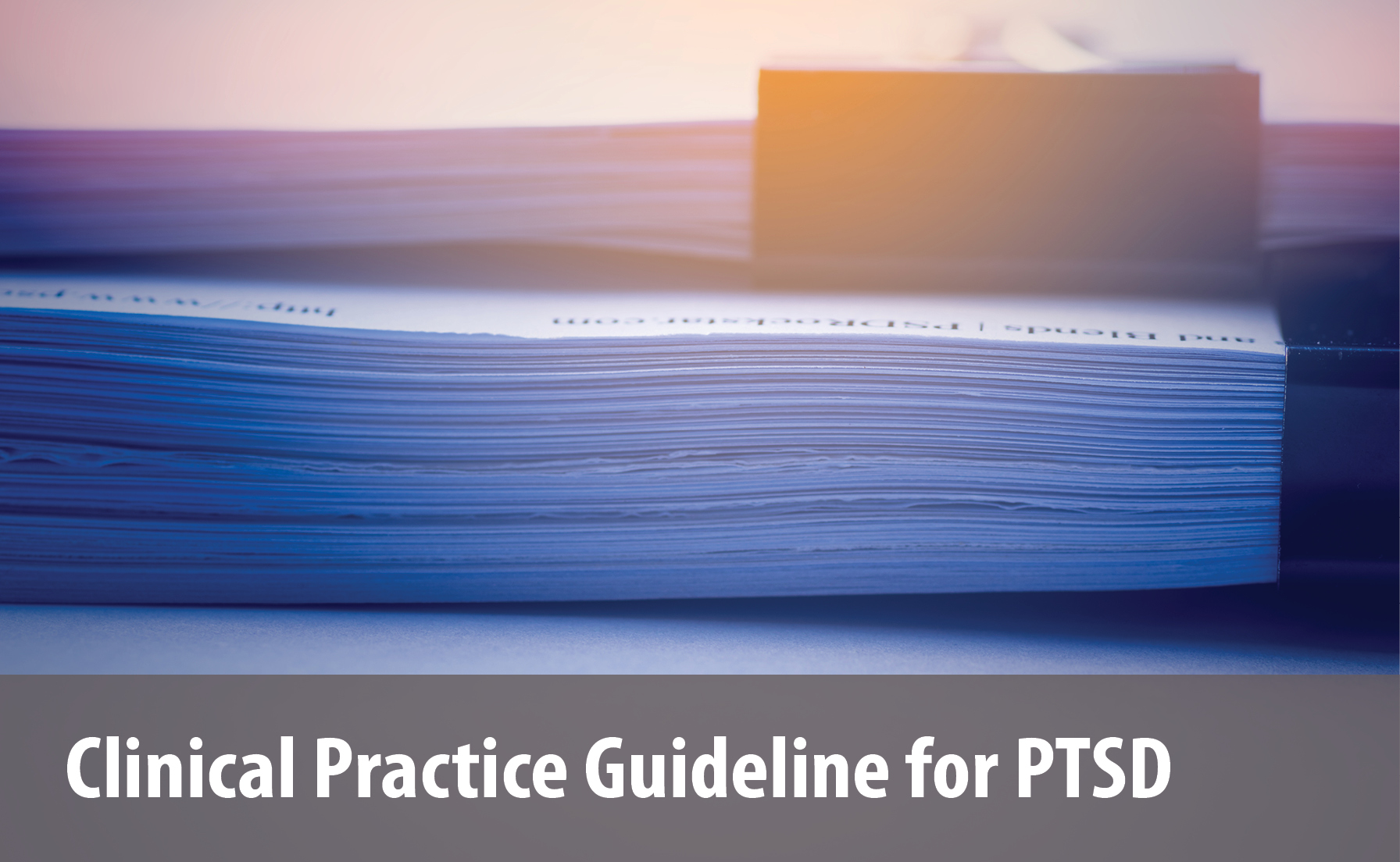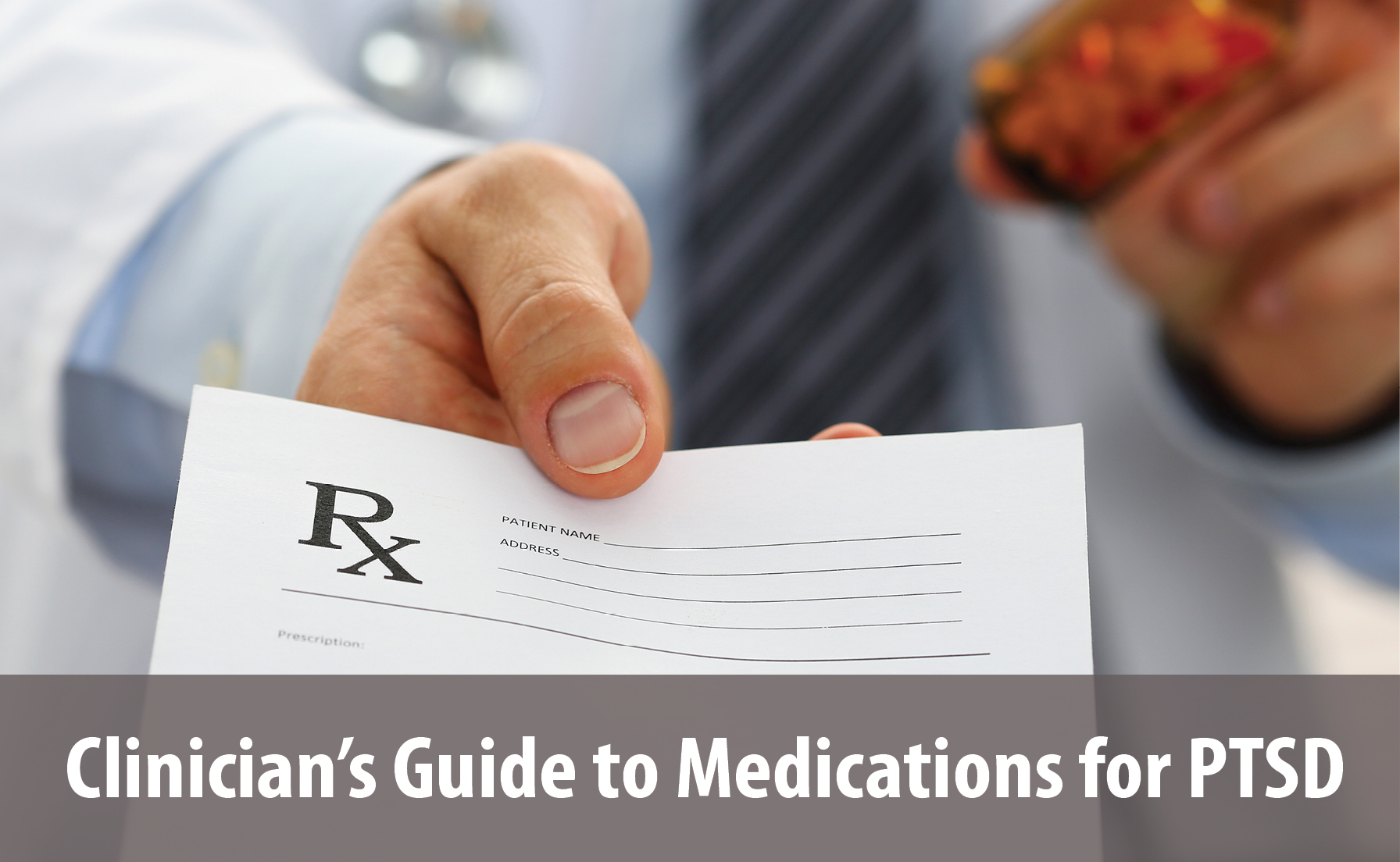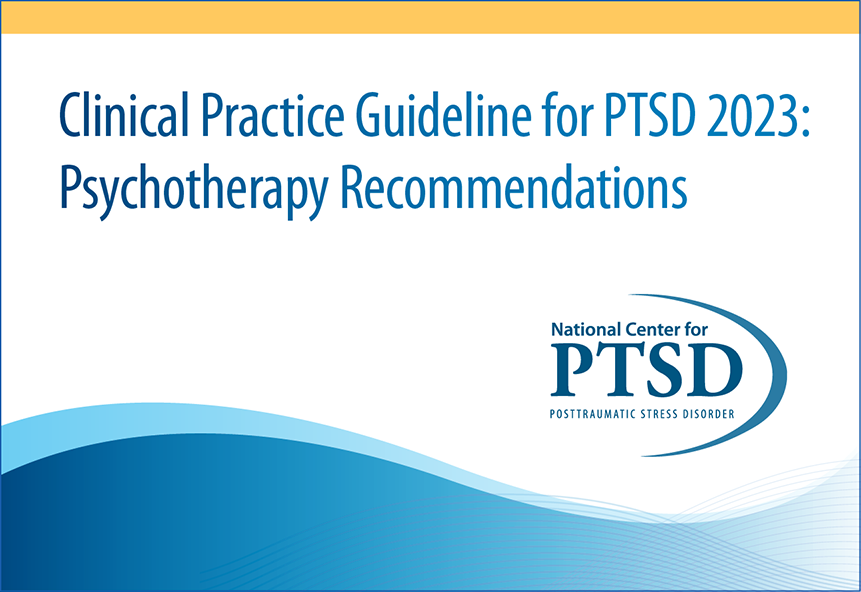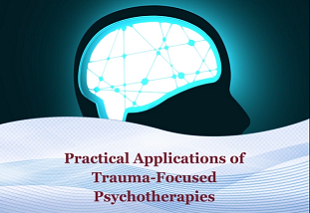Overview of Psychotherapy for PTSD
Overview of Psychotherapy for PTSD
The revised Departments of Veterans Affairs and Defense (VA/DoD) Clinical Practice Guideline (CPG) for Posttraumatic Stress Disorder (2023), as well as other clinical practice guidelines for the treatment of PTSD, recommends 3 specific trauma-focused psychotherapies, Prolonged Exposure (PE), Cognitive Processing Therapy (CPT) and Eye Movement Desensitization and Reprocessing (EMDR), as the most effective treatments for PTSD.
In This Article
Individual Trauma-Focused Psychotherapy Recommended Over Other Treatments for PTSD
The VA/DoD CPG (2023) recommends treating PTSD using individual trauma-focused psychotherapy (specifically PE, CPT, EMDR) over medications based on the current state of the PTSD treatment research (1). Although there have been few direct head-to-head comparisons of trauma-focused psychotherapy and a first-line medication for treating PTSD, a recent meta-analysis by Merz and colleagues (2019) examined comparative effectiveness studies and concluded there was greater benefit of psychological treatments (2). Two prior meta-analyses that compared the treatment effects of psychotherapies and pharmacotherapies (3,4) also showed that trauma-focused psychotherapies lead to greater improvement in PTSD symptoms than medications, and that these improvements last longer. Restricting the studies to the subset that included active controls did not change the results. In addition, the risks for negative side effects or negative reactions are generally greater with medication than with psychotherapy. A notable exception was a recent randomized controlled trial (RCT) that compared PE to sertraline and the combination (PE + sertraline) and found no differences. However, in that study medication management was more extensive than typical medication management (5).
Continuing Education
Clinical Practice Guideline for PTSD 2023: Psychotherapy Recommendations
The course reviews the 2023 VA/DoD guideline, explaining the CPG development process.
Individual trauma-focused psychotherapies may not be available in all settings and not all patients choose to engage in these treatments. In such cases, the CPG recommends certain individual, manualized psychotherapies (specifically, Cognitive Therapy (6), Written Exposure Therapy [WET], and Present Centered Therapy [PCT]; see below) or using medication (specifically, sertraline, paroxetine or venlafaxine; see Clinician's Guide to Medications for PTSD). There are no data to guide whether medication or non-trauma-focused psychotherapy is more effective in cases where trauma-focused psychotherapy is unavailable or not desired. Results of meta-analyses suggest that either one can reduce PTSD symptoms (2-4).
Trauma-Focused Psychotherapies
The CPG defines trauma-focused psychotherapy as therapy that uses cognitive, emotional, or behavioral techniques to facilitate processing a traumatic event and in which the trauma focus is a central component of the therapeutic process (4). The trauma-focused psychotherapies with the strongest evidence from clinical trials are PE, CPT, and EMDR (7-15). These treatments have been tested in numerous clinical trials, in patients with complex presentations and comorbidities, in comparison to active control conditions, and with long-term follow-up designs. Furthermore, these treatments have been validated by research teams other than the developers. There are other psychotherapies that meet the definition of trauma-focused treatment for which there is currently weak or insufficient evidence to recommend for or against their use (1).
Trauma-focused psychotherapies with the strongest evidence
The greatest number of studies have been conducted on exposure-based treatments, which involve having survivors repeatedly think about or re-tell their traumatic event. PE has received the most attention. PE includes both imaginal exposure and in vivo exposure to safe situations that have been avoided because they elicit traumatic reminders (16). In a multisite randomized controlled trial of PE in female Veterans and active-duty personnel with PTSD, those who received PE experienced greater reduction of PTSD symptoms relative to women who received Present-Centered Therapy and were less likely to meet PTSD diagnostic criteria (17). Moreover, PE was more effective than the combination of PE plus Stress Inoculation Training (SIT), SIT alone, or a waitlist control in female sexual assault survivors (18). In addition, PE alone and PE plus cognitive restructuring reduced PTSD and depression relative to a waitlist control in intention-to-treat and completer samples (19).
Continuing Education Course
Practical Applications of Trauma-Focused Psychotherapies
This course describes CPT, EMDR and PE, using a case vignette to illustrate the clinical delivery of each of these trauma-focused psychotherapies.
CPT (20), one of the most well-researched cognitive approaches, has a primary focus on challenging and modifying maladaptive beliefs related to the trauma, but can also include a written exposure component. Veterans with chronic military-related PTSD who received CPT showed better improvements in PTSD and comorbid symptoms than the waitlist control group (21). A dismantling study of CPT then examined the relative utility of the full protocol compared with its components: cognitive therapy alone and written exposure alone (22). Results indicated significant improvement in PTSD and depression for participants in all 3 treatments. However, the cognitive therapy alone resulted in faster improvement than the written exposure alone, with the effects of the full protocol of CPT falling in-between (22).
Patients receiving EMDR engage in imaginal exposure to a trauma while simultaneously performing saccadic eye movements. There is disagreement regarding the extent to which eye movements add to the effectiveness of EMDR. Two prior meta-analyses found no incremental effect for the eye movement component of EMDR (23,24). A more recent meta-analysis showed support for the effectiveness of eye movements, although the evidence was stronger for the impact of eye movement on self-reported distress than on PTSD symptoms (25).
CPT, PE and EMDR have shown great success in outcome research; thus, one logical research question involves whether one is more effective than the other. In a head-to-head comparison, CPT and PE were equally effective in treating PTSD and depression in female sexual assault survivors (26). Two well-controlled studies compared EMDR to PE. One study found equivalent results (27) while the other found PE to be superior (28). More information is needed to understand who benefits most from which of these evidence-based treatments. At this time, a patient-centered approach using shared decision-making with the patient and provider is recommended as the optimal way to choose among available treatments (1).
Other Psychotherapies With Sufficient Evidence to Recommend for the Treatment of PTSD
There are several other trauma-specific manualized cognitive behavioral therapy protocols that are suggested to reduce symptoms of PTSD (6,29-36). For example, Ehlers and Clark (37) have developed a cognitive therapy for PTSD that involves 3 goals: modifying excessively negative appraisals, correcting autobiographical memory disturbances, and removing problematic behavioral and cognitive strategies. Elements unique to Ehlers and Clark's cognitive therapy include performing actions that are incompatible with the memory or engaging in behavioral experiments. Two randomized controlled trials that used clinician-rated PTSD outcomes compared cognitive therapy to a waitlist and to active control, both with positive results (34,38).
Written Exposure Therapy (WET) focuses on writing about the trauma memory (10,39). Over 5 sessions, patients write about their trauma, with attention to details of the event and emotions experienced at the time. The writing is very briefly processed with the therapist during the subsequent session and there is no homework. WET has been shown to be superior to waitlist and non-inferior to CPT (10,39) and PE (40).
Present-Centered Therapy (PCT) is a suggested non-trauma focused alternative. PCT focuses on increasing adaptive responses to current life stressors and difficulties that are directly or indirectly related to trauma or PTSD symptoms. A systematic review of PCT that included 12 studies, found PCT was superior to waitlist and not non-inferior to trauma-focused psychotherapy; however, the effect for trauma-focused psychotherapy was superior to PCT. A potential advantage of PCT is the lower dropout rates as compared to other recommended trauma-focused therapies (41).
Therapies With Insufficient Evidence to Recommend for the Treatment of PTSD
Other treatments may be effective; however, at this time there is not enough evidence to draw conclusions (1). These include Accelerated Resolution Therapy (ART), Adaptive Disclosure (AD), Acceptance and Commitment Therapy (ACT), Brief Eclectic Psychotherapy (BEP), Dialectical Behavior Therapy (DBT), Emotional Freedom Techniques (EFT), Impact on Killing (IoK), Interpersonal Psychotherapy (IPT), Narrative Exposure Therapy (NET), Prolonged Exposure in Primary Care (PE-PC), psychodynamic therapy, psychoeducation, Reconsolidation of Traumatic Memories (RTM), Seeking Safety (SS), Stress Inoculation Training (SIT), Skills Training in Affective and Interpersonal Regulation (STAIR), Skills Training in Affective and Interpersonal Regulation in Primary Care (STAIR-PC), supportive counseling, Thought Field Therapy (TFT), Trauma-Informed Guilt Reduction (TRiGR), or Trauma Management Therapy.
In some cases, an individual may prefer PTSD treatment that includes attention focused on their intimate relationships. It is not yet known if a couples-based approach is as effective as individual trauma-focused therapy for PTSD. Overall, there is promising but limited evidence in support of trauma-focused couples therapy for PTSD (42,43).
Individuals may also be interested in group treatments. However, here too there is insufficient data to make a recommendation. A recent systematic review by Schwartze and colleagues (2019) found mixed results of trauma-focused groups to no treatment and no difference between non-trauma-focused treatments and no treatment controls. No group treatments were found to be superior to active controls nor was there benefit to adding group as an adjunctive treatment (44). One study found individual CPT was more effective than group CPT (45).
Some patients with PTSD will have an inadequate treatment response even after successful delivery of one or more courses of trauma-focused psychotherapy or other evidence-based treatments. There is no consensus in the literature on how to optimally approach the care of these patients. Patient preferences and clinical judgment are important in determining the best course of action in such cases.
Adding or Removing Components of Evidence-Based Treatments Is Not Recommended
Some investigators have added a novel component to an effective treatment in hopes of further optimizing outcomes (46-51). Several studies have examined the potential benefits of adding cognitive restructuring to exposure, with 2 studies finding benefit (33,52) and 2 studies finding no benefit (19,35). A systematic review of these studies found no added benefit of cognitive restructuring for PTSD symptom severity, loss of PTSD diagnosis and depression symptoms (53). A dismantling study of CPT, which includes both a written trauma narrative as well as cognitive therapy, examined full CPT versus the separate narrative and cognitive components (22). The cognitive only group (known as CPT-C in the study) showed faster improvement during treatment on self-rated PTSD outcomes, but the treatments did not differ significantly at post-treatment on clinician-rated PTSD and other outcomes. Based on these findings, the CPT protocol has been modified so that the written narrative is optional, and the standard protocol (now referred to as CPT) includes the cognitive component only (54).
Based on this research, the CPG does not recommend adding or removing components from evidence-based psychotherapy protocols. If modifications to an established protocol (e.g., PE, CPT, EMDR) are clinically necessary, the modifications should be empirically and theoretically guided, and with understanding of the core components of trauma-focused psychotherapies considered most therapeutically active (1).
Conclusion
Overall, PE, CPT and EMDR are the most highly recommended treatments for PTSD and have strong evidence bases. Components of these treatments have been combined with other interventions, with no support for improved benefits over the standard treatments alone. Other trauma-focused and non-trauma-focused psychotherapies can also help reduce symptoms of PTSD. More research is needed before drawing conclusions about the effectiveness of group and other psychotherapies.
References
- Department of Veterans Affairs and Department of Defense. (2023). VA/DOD Clinical Practice Guideline for the Management of Posttraumatic Stress Disorder and Acute Stress Disorder. Author. Retrieved from: https://www.healthquality.va.gov/guidelines/MH/ptsd/
- Merz, J., Schwarzer, G., & Gerger, H. (2019). Comparative efficacy and acceptability of pharmacological, psychotherapeutic, and combination treatments in adults with posttraumatic stress disorder: A network meta-analysis. JAMA Psychiatry, 76(9), 904-913. https://doi.org/10.1001/jamapsychiatry.2019.0951
- Lee, D. J., Schnitzlein, C. W., Wolf, J. P., Vythilingam, M., Rasmusson, A. M., & Hoge, C. W. (2016). Psychotherapy versus pharmacotherapy for posttraumatic stress disorder: Systematic review and meta-analyses to determine first-line treatments. Depression and Anxiety, 33(9), 792-806. https://doi.org/10.1002/da.22511
- Watts, B. V., Schnurr, P. P., Mayo, L., Young-Xu, Y., Weeks, W. B., & Friedman, M. J. (2013). Meta-analysis of the efficacy of treatments for posttraumatic stress disorder. Journal of Clinical Psychiatry, 74(6), e541-550. https://doi.org/10.4088/JCP.12r08225
- Rauch, S. A., Kim, H. M., Lederman, S., Sullivan, G., Acierno, R., Tuerk, P. W., Simon, N. M., Venners, M. R., Norman, S. B., Allard, C. B., Porter, K. E., Martis, B., Bui, E., & Baker, A. W. for the PROGress Team. (2021). Predictors of response to Prolonged Exposure, sertraline, and their combination for the treatment of military PTSD. The Journal of Clinical Psychiatry, 82(4), 34309. https://doi.org/10.4088/JCP.20m13752
- Ehlers, A., Clark, D. M., Hackmann, A., McManus, F., Fennell, M., Herbert, C., & Mayou, R. (2003). A randomized controlled trial of cognitive therapy, a self-help booklet, and repeated assessments as early interventions for posttraumatic stress disorder. Archives of General Psychiatry, 60(10), 1024-1032. https://doi.org/10.1001/archpsyc.60.10.1024
- Jericho. B., Luo, A., & Berle, D. (2022). Trauma-focused psychotherapies for post-traumatic stress disorder: A systematic review and network meta-analysis. Acta Psychiatrica Scandinavica, 145(2):132-55. https://doi.org/10.1111/acps.13366
- Sloan, D. M., Marx, B. P., Resick, P. A., Young-McCaughan, S., Dondanville, K. A., Straud, C. L., Mintz, J., Litz, B. T., & Peterson, A. L. for the STRONG STAR Consortium. (2022). Effect of Written Exposure Therapy vs Cognitive Processing Therapy on increasing treatment efficiency among military service members with posttraumatic stress disorder: A randomized noninferiority trial. JAMA Network Open, 5(1), e2140911. https://doi.org/10.1001/jamanetworkopen.2021.40911
- Thompson-Hollands, J., Marx, B. P., Lee, D. J., Resick, P. A., & Sloan, D. M. (2018). Long-term treatment gains of a brief exposure-based treatment for PTSD. Depression & Anxiety, 35(10), 985-991. https://doi.org/10.1002/da.22825
- Sloan, D. M., Marx, B. P., Lee, D. J., & Resick, P. A. (2018). A brief exposure-based treatment vs Cognitive Processing Therapy for posttraumatic stress disorder: A randomized noninferiority clinical trial. JAMA Psychiatry, 75(3), 233-239. https://doi.org/10.1001/jamapsychiatry.2017.4249
- McLean, C. P., Levy, H. C., Miller, M. L., & Tolin, D. F. (2022). Exposure therapy for PTSD in military populations: A systematic review and meta-analysis of randomized clinical trials. Journal of Anxiety Disorders, 90, 102607. https://doi.org/10.1016/j.janxdis.2022.102607
- McLean, C. P., Levy, H. C., Miller, M. L., & Tolin, D. F. (2022). Exposure therapy for PTSD: A meta-analysis. Clinical Psychology Review, 91, 102115. https://doi.org/10.1016/j.cpr.2021.102115
- Morina, N., Hoppen, T. H., & Kip, A. (2021). Study quality and efficacy of psychological interventions for posttraumatic stress disorder: A meta-analysis of randomized controlled trials. Psychological Medicine, 51(8), 1-11. https://doi.org/10.1017/s0033291721001641
- Jonas, D. E., Cusack, K., Forneris, C. A., Wilkins, T. M., Sonis, J., Middleton, J. C., Feltner, C., Meredith, D., Cavanaugh, J., Brownley, K. A., Olmsted, K. R., Greenblatt, A., Weil, A., & Gaynes, B. N. (2013, April). Psychological and pharmacological treatments for adults with posttraumatic stress disorder (PTSD). AHRQ Comparative Effectiveness Review, No. 92. Retrieved from: https://effectivehealthcare.ahrq.gov/sites/default/files/pdf/ptsd-adult-treatment_research.pdf
- Cusack, K., Jonas, D. E., Forneris, C. A., Wines, C., Sonis, J., Middleton, J. C., Feltner, C., Brownley, K. A., Olmsted, K. R., Greenblatt, A., Weil, A., & Gaynes, B. N. (2016) Psychological treatments for adults with posttraumatic stress disorder: A systematic review and meta-analysis. Clinical Psychology Review, 43, 128-41. https://doi.org/10.1016/j.cpr.2015.10.003
- Foa, E. B., & Rothbaum, B. O. (1998). Treating the trauma of rape: Cognitive behavioral therapy for PTSD. Guilford.
- Schnurr, P. P., Friedman, M. J., Engel, C. C., Foa, E. B., Shea, M. T., Chow, B. K., Resick, P. A., Thurston, V., Orsillo, S. M., Haug, R., Turner, C., & Bernardy, N. (2007). Cognitive behavioral therapy for posttraumatic stress disorder in women: A randomized controlled trial. Journal of the American Medical Association, 297(8), 820-830. https://doi.org/10.1001/jama.297.8.820
- Foa, E. B., Dancu, C.V., Hembree, E. A., Jaycox, L.H., Meadows, E. A., & Street, G.P. (1999). A comparison of exposure therapy, Stress Inoculation Training, and their combination for reducing posttraumatic stress disorder in female assault victims. Journal of Consulting and Clinical Psychology, 67(2), 194-200. https://doi.org/10.1037//0022-006X.67.2.194
- Foa, E. B., Hembree, E. A., Cahill, S. P., Rauch, S. A. M., Riggs, D. S., Feeny, N. C., & Yadin, E. (2005). Randomized trial of Prolonged Exposure for posttraumatic stress disorder with and without cognitive restructuring: Outcome at academic and community clinics. Journal of Consulting and Clinical Psychology, 73(5), 953-964. https://doi.org10.1037/0022-006X.73.5.953
- Resick, P.A., & Schnicke, M. K. (1996). Cognitive Processing Therapy for rape victims: A treatment manual. Sage Publications.
- Monson, C. M., Schnurr, P. P., Resick, P. A., Friedman, M. J., Young-Xu, Y., & Stevens, S. P. (2006). Cognitive Processing Therapy for Veterans with military-related posttraumatic stress disorder. Journal of Consulting and Clinical Psychology, 74(5), 898-907. https://doi.org/10.1037/0022-006X.74.5.898
- Resick, P. A., Galovski, T. E., Uhlmansiek, M. O., Scher, C. D., Clum, G. A., & Young-Xu, Y. (2008). A randomized clinical trial to dismantle components of Cognitive Processing Therapy for posttraumatic stress disorder in female victims of interpersonal violence. Journal of Consulting and Clinical Psychology, 76(2), 243-258. https://doi.org/10.1037/0022-006X.76.2.243
- Devilly, G. J. (2002). Eye Movement Desensitization and Reprocessing: A chronology of its development and scientific standing. The Scientific Review of Mental Health Practice, 1(2), 113-138.
- Davidson, P. R., & Parker, K. C. H. (2001). Eye Movement Desensitization and Reprocessing (EMDR): A meta-analysis. Journal of Consulting and Clinical Psychology, 6(2), 305-316. https://doi.org/10.1037//0022-006X.69.2.305
- Lee, C. W., & Cuijpers, P. (2013). A meta-analysis of the contribution of eye movements in processing emotional memories. Journal of Behavior Therapy and Experimental Psychiatry, 44(2), 231-239. https://doi.org/10.1016/j.jbtep.2012.11.001
- Resick, P. A., Nishith, P., Weaver, T. L., Astin, M. C., & Feuer, C. A. (2002). A comparison of Cognitive Processing Therapy with Prolonged Exposure and a waiting condition for the treatment of chronic posttraumatic stress disorder in female rape victims. Journal of Consulting and Clinical Psychology, 70(4), 867-879. https://doi.org/10.1037/0022-006X.70.4.867
- Rothbaum, B. O., Astin, M. C., & Marstellar, F. (2005). Prolonged Exposure versus Eye Movement Desensitization and Reprocessing (EMDR) for PTSD rape victims. Journal of Traumatic Stress, 18(6), 607-616. https//doi.org/10.1002/jts.20069
- Taylor, S., Thordarson, D. S., Maxfield, L., Fedoroff, I.C., Lovell, K., & Ogrodniczuk, J.S. (2003). Comparative efficacy, speed, and adverse effects of three PTSD treatments: Exposure therapy, EMDR, and relaxation training. Journal of Consulting and Clinical Psychology, 71(2), 330-338. https://doi.org/10.1037/0022-006X.71.2.330
- Ehlers, A., Grey, N., Wild, J., Stott, R., Liness, S., Deale, A., Handley, R., Albert, I. Cullen, D., Hackmann, A., Manley, J., McManus, F., Brady, F., Salkovskis, P., & Clark, D. M. (2013). Implementation of cognitive therapy for PTSD in routine clinical care: Effectiveness and moderators of outcome in a consecutive sample. Behaviour Research and Therapy, 51(11), 742-752. https://doi.org/10.1016/j.brat.2013.08.006
- Ehlers, A., Hackmann, A., Grey, N., Wild, J., Liness, S., Albert, I., Deale, A., Scott, R., & Clark, D. M. (2014). A randomized controlled trial of 7-day intensive and standard weekly cognitive therapy for PTSD and emotion-focused supportive therapy. American Journal of Psychiatry, 171(3), 294-304. https://doi.org/10.1176/appi.ajp.2013.12040552
- Blanchard, E. B., Hickling, E. J., Devineni, T., Veazey, C. H., Galovski, T. E., Mundy, E., Malta, L. S. & Buckley, T. C. (2003). A controlled evaluation of cognitive behavioral therapy for posttraumatic stress in motor vehicle accident survivors. Behaviour Research and Therapy, 41(1), 79-96. https://doi.org/10.1016/S0005-7967(01)00131-0
- Bryant, R. A., Mastrodomenico, J., Felmingham, K. L., Hopwood, S., Kenny, L., Kandris, E., Cahill, C., & Creamer, M. (2008). Treatment of acute stress disorder: A randomized controlled trial. Archives of General Psychiatry, 65(6), 659-667. https://doi.org/10.1001/archpsych.65.6.659
- Bryant, R. A., Moulds, M. L., Guthrie, R. M., Dang, S. T., Mastrodomenico, J., Nizon, R. D. V., Felmingham, K. L., Hopwood, S., & Creamer, M. (2008). A randomized controlled trial of exposure therapy and cognitive restructuring for posttraumatic stress disorder. Journal of Consulting and Clinical Psychology, 76(4), 695-703. https://doi.org/10.1037/a0012616
- Kubany, E. S., Hill, E. E., Owens, J. A., Iannce-Spencer, C., McCaig, M. A., Tremayne, K. J., & WIlliams, P. L. (2004). Cognitive trauma therapy for battered women with PTSD (CTT-BW). Journal of Consulting and Clinical Psychology, 72(1), 3-18. https://doi.org/10.1037/0022-006X.72.1.3
- Marks, I., Lovell, K., Noshirvani, H., Livanou, M., & Thrasher, S. (1998). Treatment of posttraumatic stress disorder by exposure and/or cognitive restructuring: A controlled study. Archives of General Psychiatry, 55(4), 317-325. https://doi.org/10.1001/archpsyc.55.4.317
- Power, K., McGoldrick, T., Brown, K., Buchanan, R., Sharp, D., Swanson, V., & Karatzias, A. (2002). A controlled comparison of Eye Movement Desensitization and Reprocessing versus exposure plus cognitive restructuring versus waiting list in the treatment of post-traumatic stress disorder. Clinical Psychology & Psychotherapy, 9(5), 299-318. https://doi.org/10.1002/cpp.341
- Ehlers, A., & Clark, D. M. (2000). A cognitive model of posttraumatic stress disorder. Behavioral Research and Therapy, 38(4), 319-345. https://doi.org/10.1016/S0005-7967(99)00123-0
- Duffy, M., Gillespie, K., & Clark, D. M. (2007). Post-traumatic stress disorder in the context of terrorism and other civil conflict in Northern Ireland: Randomised controlled trial. British Medical Journal, 334, 1147-1150. https://doi.org/10.1136/bmj.39021.846852.BE
- Sloan, D. M., Marx, B. P., Bovin, M. J., Feinstein, B. A., & Gallagher, M. W. (2012). Written exposure as an intervention for PTSD: A randomized clinical trial with motor vehicle accident survivors. Behaviour Research and Therapy, 50(10), 627-635. https://doi.org/10.1016/j.brat.2012.07.001
- Sloan, D.M., Mark, B. P., Acierno, R., Messina, M., Muzzy, W., Gallagher, M. W., Litwack, & Sloan, C. (2023). Written Exposure Therapy versus Prolonged Exposure in the treatment of PTSD: A randomized non-inferiority clinical trial. JAMA Psychiatry, 80(11), 1093-1100. https://doi.org/10.1001/jamapsychiatry.2023.2810
- Belsher, B. E., Beech, E., Evatt, D., Smolenski, D. J., Shea, M.T., Otto, J. L., Rosen, C. S., & Schnurr, P. P. (2019). Present-Centered Therapy (PCT) for post-traumatic stress disorder (PTSD) in adults. Cochrane Database Systematic Reviews, 11. https://doi.org/10.1002/14651858.CD012898.pub2
- Monson, C. M., Fredman, S. J., Macdonald, A., Pukay-Martin, N. D., Resick, P. A., & Schnurr, P. P. (2012). Effect of cognitive-behavioral couple therapy for PTSD: A randomized controlled trial. Journal of the American Medical Association, 308(7), 700-709. https://doi.org/10.1001/jama.2012.9307
- Sautter, F. J., Glynn, S. M., Cretu, J. B., Senturk, D., & Vaught, A. S. (2015). Efficacy of structured approach therapy in reducing PTSD in returning Veterans: A randomized clinical trial. Psychological Services, 12(3), 199-212. https://doi.org/10.1037/ser0000032
- Schwartze, D., Barkowski, S., Strauss, B., Knaevelsrud, C., & Rosendahl, J. (2019). Efficacy of group psychotherapy for posttraumatic stress disorder: Systematic review and meta-analysis of randomized controlled trials. Psychotherapy Research, 29(4), 415-431. https://doi.org/10.1080/10503307.2017.1405168.
- Resick, P. A., Wachen, J. S., Dondanville, K. A., Pruiksma, K. E., Yarvis, J. S., Peterson, A.L., Mintz, J., & the STRONG STAR Consortium. (2017). Effect of group vs individual Cognitive Processing Therapy in active-duty military seeking treatment for posttraumatic stress disorder: A randomized clinical trial. JAMA Psychiatry, 74(1), 28-36. https://doi.org/10.1001/jamapsychiatry.2016.2729
- Lindauer, R. J., Gersons, B. P., van Meijel, E. P., Blom, K., Carlier, I. V. E., Vrijlandt, I. & Olff, M. (2005). Effects of brief eclectic psychotherapy in patients with posttraumatic stress disorder: Randomized clinical trial. Journal of Traumatic Stress, 18(3), 205-212. https://doi.org/10.1002/jts.20029
- Arntz, A., Tiesema, M., & Kindt, M. (2007). Treatment of PTSD: A comparison of imaginal exposure with and without imagery rescripting. Journal of Behavioral Therapy and Experimental Psychiatry, 38(4), 345-370. https://doi.org/10.1016/j.jbtep.2007.10.006
- Cloitre, M., Koenen, K. C., Cohen, L.R., & Han, H. (2002). Skills Training in Affective and Interpersonal Regulation followed by exposure: A phase-based treatment for PTSD related to childhood abuse. Journal of Consulting and Clinical Psychology, 70(5), 1067-1074. https://doi.org/10.1037//0022-006X.70.5.1067
- Falsetti, S.A., Resnick, H. S., & Davis, J. L. (2008). Multiple channel exposure therapy for women with PTSD and comorbid panic attacks. Cognitive Behaviour Therapy, 37(2), 117-130. https//doi.org/10.1080/16506070801969088
- Glynn, S. M., Eth, S., Randolph, E.T., Foy, D. W., Urbaitis, M., & Boxer, L. (1999). A test of behavioral family therapy to augment exposure for combat-related posttraumatic stress disorder. Journal of Consulting and Clinical Psychology, 67(2), 243-251. https://doi.org/10.1037//0022-006X.67.2.243
- Högberg, G., Pagani, M., Sundin, Ö., Soares, J. J. F., Åverg-Wistedt, A., Tarnell, B, & Hällström, T. (2008). Treatment with Eye Movement Desensitization and Reprocessing of chronic post-traumatic stress disorder in public transportation workers: Outcome is stable in 35-month follow-up. Psychiatric Research, 159(1-2), 101-108. https://doi.org/10.1016/j.psychres.2007.10.019
- Bryant, R. A., Moulds, M. L., Guthrie, R. M., Dang, S. T., & Nixon, R. D. V. (2003). Imaginal exposure alone and imaginal exposure with cognitive restructuring in treatment of posttraumatic stress disorder. Journal of Consulting and Clinical Psychology, 71(4), 706-712. https://doi.org/10.1037/0022-006X.71.4.706
- Markowitz, J. C., Petkova, E., Biyanova, T., Ding, K., Suh, E. J., & Neria, Y. (2015). Exploring personality diagnosis stability following acute psychotherapy for chronic posttraumatic stress disorder. Depression and Anxiety, 32(12), 919-926. https://doi.org/10.1002/da22436
- Resick, P. A., Monson, C. M., & Chard, K. M. (2106). Cognitive Processing Therapy for PTSD: A comprehensive manual. Guilford Publications.
You May Also Be Interested In

VA/DoD Clinical Practice Guideline for PTSD (2023)
Get information on evidence-based treatment recommendations for PTSD.

Clinician's Guide to Medications for PTSD
Get key information and guidance on the best medications for PTSD.


























